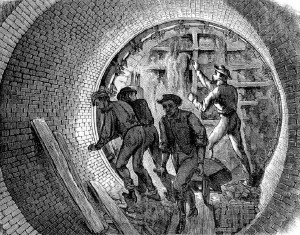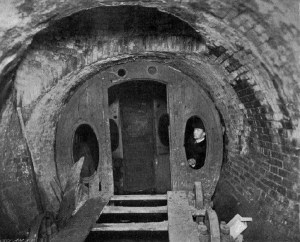And, I missed it. By one week. Nuts. Perhaps one of the coolest events in NYC history. This was the thing that inspired me to learn more about this city and it happened on February 26th, 1870 and I totally missed. Well, whatever. I’m still going to write about it, late though it may be.

Look at that poop! It could reach 3.5 feet.
We are going to travel back to the late 1860’s, a time when New York was booming. The Civil War is over, and the city is doing just fine. The population was getting so big that by this point we had no choice but to expand northward and occupy more of Manhattan. The one major roadblock was our system of public transit was garbage. For the most part, we had large horse-drawn carriages called “omnibuses” that worked just like modern buses today — they had a set route, and for a fare, someone could jump on the bus and jump off when they needed to. The driver had a piece of leather tied around his ankle, and when someone wanted off, they would pull on the leather. Problem was, the omnibus system was slow, dirty and expensive for the time. The streets of New York were absolutely covered in horse poop, and because the carriages wouldn’t go more than three miles an hour, people had to live close to their work. This resulted in very overpopulated areas where the poor working class had to live within walking distance of work.
The only solution was to create a system of mass rapid transit. There was a big debate about the future of transportation in NYC — whether it should be subways, elevated trains or something else entirely. Eventually, the elevated trains won for a couple of different reasons. First of all, the technology that we use today didn’t exist, and there wasn’t an electric motor that would have worked. Instead, they would have had to use a steam locomotive, which underground in a tunnel, would have most likely ended up suffocating people from all the exhaust coming from the engine itself. Also, digging a subway under a city that already was in place would have been very expensive. The elevated trains would have been relatively cheap, and the railroad companies had given the ruling party of New York, Tammany Hall, a substantial bribe to build the trains. Boss Tweed, the infamous Tammany Hall Boss, was in charge at this point, and if the money was right he would let you do whatever you wanted. So Tweed got his beak wet, and the elevated trains were a go.

Alfred E. Beach — genius.
Now, enter the hero of our story — Alfred Beach! Editor of Scientific American and inventor extraordinaire! Beach knew that a subway was possible, but he knew that it would never happen with Tweed’s knowledge. So he would have to build one himself, sneakily.
The city wanted a system of pneumatic tubes going up and down Manhattan to help deliver mail quickly, kind of like what they had at the drive-up window at the bank when I was a kid. You put your letter in a cylinder, put that in the tube, and a powerful vacuum would suck the cylinder down the tube all the way to the other end of the city. Alfred Beach won the contract, made the tubes, but then he started to make something else.

This drawing can give you a better idea of what the tube did — you can see the steam engine and the track the car would travel on. Plus, how fancy is that car?
While he was building the mail tubes, he started, in secret, to build another, bigger tube. This one was about six feet in diameter directly underneath Broadway. His plan was to create basically a giant mail cylinder to put people in and then shoot them down the tube. It would work on the same principal as his other pneumatic tubes — he would build a huge steam engine powered fan that would blow the cylinder at about 10 miles and hour. When the tube hit a certain point in the tracks, it would hit a switch that made the fan turn the opposite direction, slowing the cylinder down. Then, the cylinder would be sucked back the opposite way to complete the trip, just like at the bank. It was a smooth, fast efficient ride.
They had to work, only at night, so as not to draw attention. Beach was worried that they were not tunneling straight, so every now and then he would drill up to the street, run up and make sure all the holes lined up properly. When it was all done, he had a clean, well lit, brick-lined subway that was fully functional. The cylinder, or the subway car, was outfitted with a couch, lamps, and all the amenities you would find in an upper class home. He had built the whole thing, under Broadway, going between Murray and Warren Street, and nobody knew that he had done it.

This is how they were able to create the tunnel — there was a large “shield” that would slowly bore a hole through the earth. As it traveled, the workers would quickly brick up the area it dug out, creating the tube. This is very similar to how they created tunnels under the East River decades later.

Here is the complete station — you can see people waiting in line to get into the little car, that would take them about 300 feet down to the next block. That’s as far as it went, one city block!
When he finally revealed his creation, people freaked out. He charged $.25 a ride, and about 400,000 people jumped on board. They came down into the subway to see a grand piano, fish tanks stocked with goldfish, chandeliers, and then jumped into the car to be whisked down the tracks to the other end of the tunnel. It was an overnight success, and Beach had proven that a subway was a possibility in New York. It was so popular that everyone was now on board with a subway being built.
Tweed, on the other hand, blew a gasket! He used all his power and influence to shut the project down. Beach had petitioned to make a subway going up Manhattan, but to no avail. Tweed was just too powerful, and he did not want a subway ruining the good thing he had going on with the elevated trains. Not long after, there was a serious Stock Market Crash, and Beach had given up all hope of making a subway. He shut down the pneumatic tube, and someone else turned it into a shooting gallery for a few years, but then it was forgotten. Almost four decades later, when the city was installing a new subway line with the BMT, they tunneled into the old pneumatic tube. It was still there, under Broadway the whole time. Even the car itself remained, decayed though it was. Some of the pieces were salvaged and kept as souvenirs, but the new subway line plowed right on through it and destroyed all that remained of the first subway in New York City.
So now, when you go and watch Ghostbusters 2, and you see the scene where they find the River of Slime in the old pneumatic tubes, you’ll know what they are talking about.



